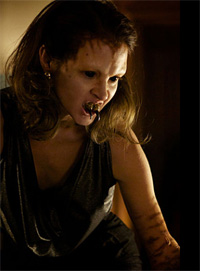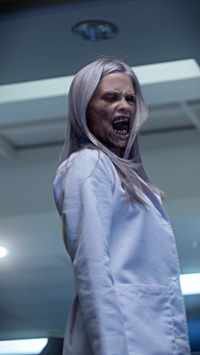Grimm and the Monstrous Feminine
 Once upon a time, a new genre of fairy-tale-based American media emerged. Instead of Disney’s dancing teapots and talking birds, thrillers like Red Riding Hood, The Brothers Grimm, and Hanna point out that “Little Red Riding Hood” and “Snow White” are actually stories about young girls devoured by wild animals and ordered gutted by monstrous queens, respectively. This darker side of fairy tale culture is the spirit of NBC’s newly renewed Grimm. I initially shared Kyra Hunting’s skepticism about the series, but the gorgeous cinematography and cleverly adapted fairy tale plotlines hooked me (and the other 5.3 million viewers who tuned in for Friday night’s season finale), despite a nagging feeling that Grimm’s monstrous women told a politically problematic tale.
Once upon a time, a new genre of fairy-tale-based American media emerged. Instead of Disney’s dancing teapots and talking birds, thrillers like Red Riding Hood, The Brothers Grimm, and Hanna point out that “Little Red Riding Hood” and “Snow White” are actually stories about young girls devoured by wild animals and ordered gutted by monstrous queens, respectively. This darker side of fairy tale culture is the spirit of NBC’s newly renewed Grimm. I initially shared Kyra Hunting’s skepticism about the series, but the gorgeous cinematography and cleverly adapted fairy tale plotlines hooked me (and the other 5.3 million viewers who tuned in for Friday night’s season finale), despite a nagging feeling that Grimm’s monstrous women told a politically problematic tale.
Grimm’s weekly plotlines, developed around Jacob and Wilhelm Grimm’s 1812 Children’s and Household Tales, follow the modern crime genre format. The series follows Detective Nick Burkhardt, a Portland police officer dismayed by his great aunt’s revelation that he is a “Grimm” – a descendent of the Brothers Grimm whose powers allow him to see pseudo-shape-shifting Wesen whose otherwise human faces transform into grotesque configurations reminiscent of big bad wolves, evil witches, giants, and the like. What’s worse, these creatures-in-disguise often partake in inter-species violence, resulting in many of Portland PD’s murder cases. The series is as much police drama as fairy tale, featuring—like CSI, Criminal Minds, and NCIS—dimly lit camera shots, stealthy detectives with guns and flashlights, and, of course, women’s bloody and broken bodies.
 Dead women are standard set dressing on most crime dramas, so I wasn’t surprised by the ill-fated red-hooded coed in Grimm’s pilot. But the more I watched, the more I realized the women in this series aren’t usually homicide victims – they’re monsters. The first morphing face belongs to a beautiful Hexenbiest (loosely translated “witch bitch”) named Adalind whose Barbie-esque blond exterior hideously contorts to reveal that Grimm’s beauty is only skin deep. Adalind makes consistently dangerous choices, using her beauty—and the monstrous truth beneath it—to ruin men. Not only does she cast a love spell on Nick’s partner Hank, she also kills an elderly cancer patient and unleashes an impressive physical attack on Nick – she uses her beauty, NBC muses, to “put any man completely at her mercy.” Adalind is the monstrous feminine who seduces men before castrating them, at least figuratively, with her power.
Dead women are standard set dressing on most crime dramas, so I wasn’t surprised by the ill-fated red-hooded coed in Grimm’s pilot. But the more I watched, the more I realized the women in this series aren’t usually homicide victims – they’re monsters. The first morphing face belongs to a beautiful Hexenbiest (loosely translated “witch bitch”) named Adalind whose Barbie-esque blond exterior hideously contorts to reveal that Grimm’s beauty is only skin deep. Adalind makes consistently dangerous choices, using her beauty—and the monstrous truth beneath it—to ruin men. Not only does she cast a love spell on Nick’s partner Hank, she also kills an elderly cancer patient and unleashes an impressive physical attack on Nick – she uses her beauty, NBC muses, to “put any man completely at her mercy.” Adalind is the monstrous feminine who seduces men before castrating them, at least figuratively, with her power.
I can’t say that I’m surprised by Grimm’s monstrous femininity. Fairy tales (and crime dramas, for that matter) are morally instructive, recycling cultural fears into cautionary tales, and Grimm funnels the mythos of women’s irresponsibility and cold indifference into a crime drama. “Tarantella,” for example, features a Spinnetod (or “black widow”) – a mother who seduces men before sucking out their internal organs through their abdomen – and the Cinderella-turned-Murciélago (“hideous bat-like creature”) in “Happily Ever Aftermath” emits a shrieking sound that explodes her entire family’s eyeballs, leaving herself heir to her father’s fortune. It is from these stories that we learn what a “good mother” looks like, and she certainly wouldn’t seduce men in the name of eternal youth. And “good women” like Cinderella are rewarded through quiet suffering, not monstrous murder.
Grimm emerged from a cultural climate particularly interested in moral instruction, as evidenced by recent legislative fervor over women’s choice. Last week, Kansas legally allowed pharmacists to withhold prescriptions they “reasonably believe” could terminate pregnancy, the “Protect Life Act” allows hospitals to “let women die” rather than perform life-saving abortions, and of course, transvaginal ultrasound legislation requires women to be probed vaginally before terminating a pregnancy. These bills are just as terrifying as, say, tales of fire-breathing lady-Dämonfeuer, which also come from the assumption that women’s free (and presumed irresponsible) choice destroys American morality in a fury of fire and brimstone. Just as Grimm’s monstrous women threaten men, GOP politics frames women’s rights as a threat to family values, “fetal rights,” and men’s sovereignty. Grimm naturally channels this milieu, borrowing from traditional anxiety about strong, independent women encapsulated by the Brothers Grimm.
As Grimm’s first season wrapped up, the monstrous women were back. Adalind sicked her cat on Nick’s fiancé, turning her into a modern-day (comatose) sleeping beauty, and the mysterious “woman in black” unleashed a flurry of ninja-like moves before revealing her identity as (spoiler alert) Nick’s mother, long thought dead. Missing mothers are common in fairy tales, but Grimm’s finale raises the question: if Nick’s mother has been alive all of these years, why hasn’t she been mothering him? Even though the woman in black may not be the archetypal “evil stepmother,” I’m not holding my breath for a “happily ever after” moment in Grimm’s second season – what kind of a boring fairy tale leaves a “good mother” alive? We’ll have to wait until fall to see if her crime was drinking children’s blood or simply disappearing from her child’s life. Or maybe Grimm will give us a truly updated fairy tale – you know, one with progressive female characters.



I really enjoy “Grimm,” so I’m glad you are writing about it. I agree that sex is often framed through the menacing energy of female allure, but I also see characters like Nick’s aunt (who, while odd, had a good relationship with Nick) and his partner, Juliette, as attempts to balance the menace, at least in relation to Nick. The arrival of the spice shop woman has also helped move the show in a new direction, with the woman as a knower and a healer.
What do you make of the episode “The Things with Feathers,” featuring a battered girlfriend? She’s forcibly fed by the partner to nurture the egg she carries in her throat. The physical violence depicted, particularly as it is read by Nick and Juliette, reads as domestic violence. The forced feeding is a violation akin to rape, and the attention to controlling her reproductive energies a possible commentary on the medicalization of pregnancy or perhaps even a woman’s right to choose. In this way, the show also demonstrates a preoccupation with how women are victimized by men.
The gender politics is not liberatory or transgressive, but I have more hope than you that the show will develop its females in season 2.
Thanks for your comment! You certainly bring up a valid position here. And I’m with you regarding the healer character, who I find to be the most interesting of the show’s women — I’d love to see more of her!
My issue, and this is a beef I have with most procedurals, is that the female characters are broken into two camps — either you’re strong (in which case you are a monster with no self control) or you’re a victim (the bird character in “The Things with Feathers” would be an example, but I have also been waiting for the other shoe to drop with Juliette — she’s had a target on her back for weeks). Most procedurals at least have a woman or two on the police force to soften the dichotomy a bit!
I also find representations of women’s victimization to be a tricky area, though you make a good point about the domestic violence theme of “The Things with Feathers.” While representations of domestic violence can certainly work towards demonstrating women’s victimization by men, I think there is also a way in which the spectacle of suffering women normalizes and fictionalizes real suffering bodies (perhaps exacerbated by the bizarre visuals of that particular episode). And when sexualized violence is on display, I worry about the fetishization of suffering. . .
I also enjoy Grimm, and I think it has much to offer (even if I’m skeptical about the politics). Here’s hoping you’re right about its season two women!
Thank you for a great post. I have been working on a three-tier class about women in procedurals, as victim, prosecutor, perpetrator, and have been thinking about the extreme stereotyping I found as well as the fantasy and science-fiction shows on cable in connection quite a bit lately.
I agree that there appears to be a clear gap between victims and “monsters” here, one deeply rooted in classic fairytales, with no bridging female characters. Both Juliette and the Fuchsbau (literally: foxes den – I have to say I do have a laugh and a problem every time they use German in such awkward and wrong ways) are positive female characters, but both are victimized REPEATEDLY. And while the Fuchsbau can heal she needs saving herself by men still.
In that way the series, which in so many ways reminds me of Supernatural, needs a female warrior on the side of the good, but that can easily turn into a much unneeded female stereotype joining the show. Maybe his mother makes the perfect female character to fill that void, who knows. But I am counting on the series renewal to bring with it inspired new writing.
Also, it seems to me that the idea of mothers you bring up is a subject on its own, and one that possibly warrants closer analysis. The suburban spider, the Hexenbiest’s dance-mom mother, and the good aunt taking on the role of mother represent that specific aspect of being a woman in many interesting ways.
Looking forward to the new season already.
[…] e i personaggi femminili: Amanda Edgar evidenzia come la serie della NBC abbia dei grossi problemi nella creazione di personaggi femminili che non […]